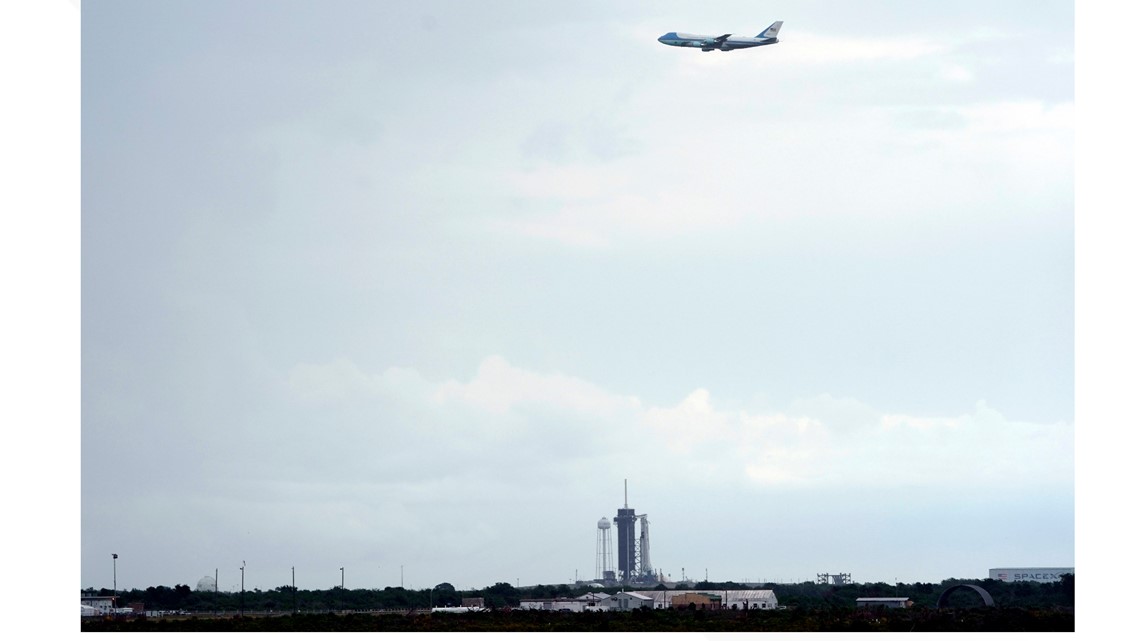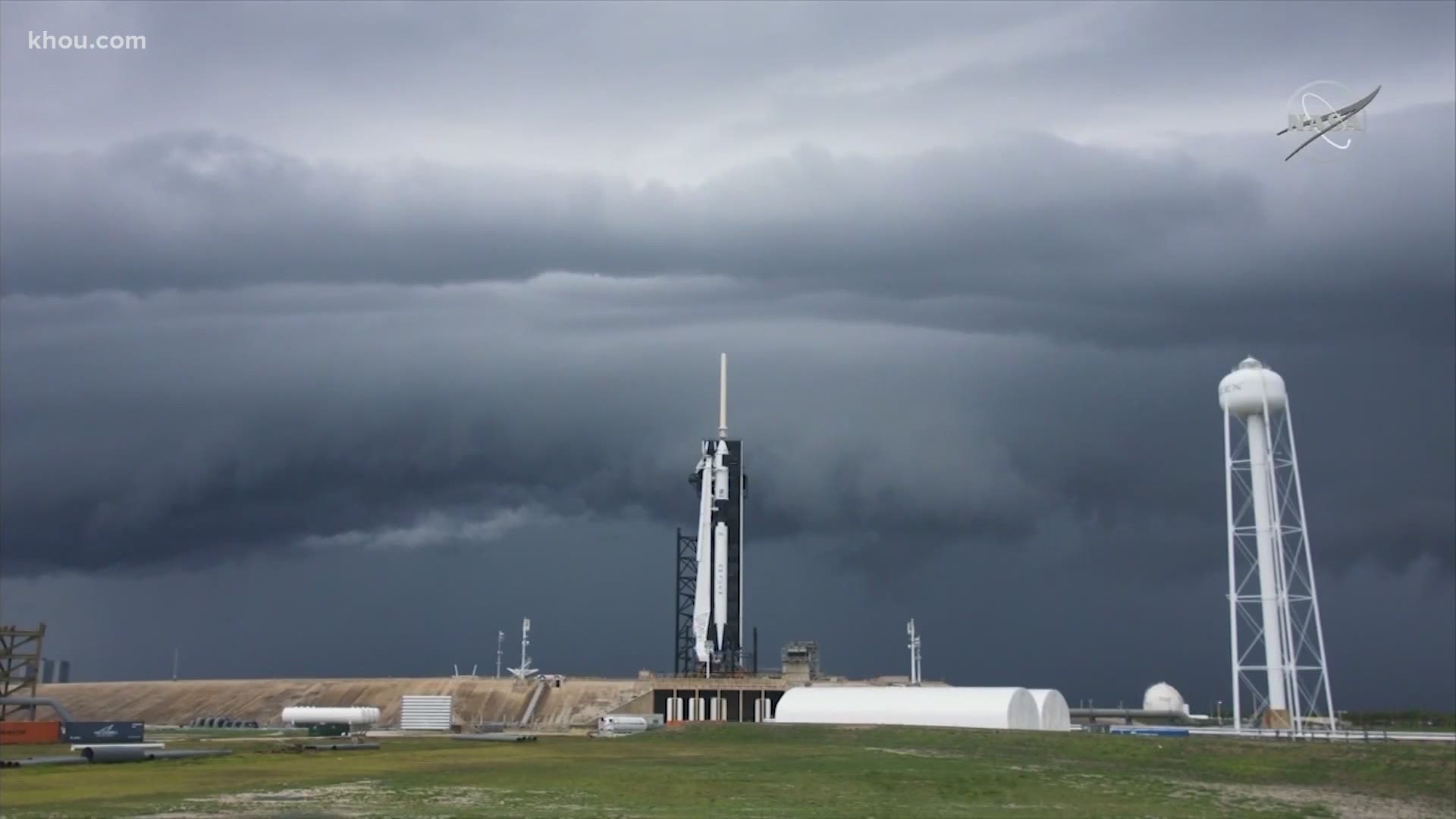HOUSTON — BREAKING: Today's launch has been postponed due to weather. The next launch is scheduled for Saturday at 2:22 p.m. CST.
The SpaceX Falcon 9 rocket will lift off the International Space Station this afternoon with two Houston-based astronauts onboard.
This is the first-time astronauts will blast off from U.S. soil since the space shuttle program ended in 2011.
Astronauts Bob Behnken and Doug Hurley have been training for this day for the past several years. Much of that time was spent in Houston at the Johnson Space Center.
Top Related Headlines
- Weather forecast still looks iffy -- but better -- for historic SpaceX, NASA launch
- How the weather can delay the NASA SpaceX launch
- If Crew Dragon doesn't launch Wednesday, when will it happen?
- Here's how Crew Dragon compares to the 8 other spaceships that have carried humans
- Houston's Johnson Space Center will play critical role in #LaunchAmerica NASA, SpaceX flight Wednesday
- #LaunchAmerica team gets 'go for launch' from NASA, SpaceX managers
Also you can text 'LAUNCH' to 713-526-1111 for the latest on today's historic launch.
How to watch today's historic launch
NASA will provide live coverage of pre-launch and launch activities for the SpaceX test flight beginning at 11:15 a.m. You can stream it in the player at the top of the article and on the KHOU 11 News app.
KHOU 11 News will begin our pre-launch online coverage at 3 p.m. and you can stream it in the player above and on our app, Facebook page, YouTube channel and on Twitter.
You can begin watching on KHOU 11/CBS on air beginning at 3:20 p.m.
Latest launch updates
Wednesday, May 27
3:18 p.m. — Today's launch has been scrubbed due to bad weather. The next launch date is scheduled for Saturday.
2:51 p.m. — The crew access arm retracts from Falcon 9 rocket as we inch closer to liftoff.
2:48 p.m. — Bill Nye sends his congrats to SpaceX and well wishes to astronauts Bob Behnken and Doug Hurley on their mission.
2:36 p.m. — Astronauts Bob Behnken and Doug Hurley tell Mission Control they are "go for launch." T-minus 57 minutes.
2:07 p.m. — President Donald Trump and first lady Melania Trump land at Cape Canaveral to watch the historic launch.


1:47: p.m. — Hatch closed and crew settled in
12:53 p.m. — Strapped in and ready!
12:42 p.m. — NASA astronauts Doug Hurley and Bob Behnken arrive at launch pad.
12:35 p.m. — Headed to the pad.
12:17 p.m. — NASA astronauts Doug Hurley and Bob Behnken walk out of the suit room to depart to the pad.
12:00 p.m. — NASA Administrator Jim Bridenstine and SpaceX CEO Elon Musk met up with the astronauts prior to today's launch.
11:45 a.m. — Time to gear up!
11:22 a.m. — NASA Administrator Jim Bridenstine tweeted: "We are go for launch! @SpaceX and @NASA will continue monitoring liftoff and downrange weather as we step into the countdown. We are proceeding toward a 4:33 (ET) launch."
10:45 a.m. — "Launch day, In America." Astronaut Col. Bob Behnken.
10:10 a.m. — Astronaut Col. Doug Hurley getting a good breakfast in before today's launch.
9:00 a.m. — The U.S. Marine Corps showing their support for Col. Doug Hurley.
8:00 a.m. — NASA and SpaceX are keeping an eye on the weather but launch is still a go at this point.
7:00 a.m. — What a view of the platform this morning.
Why does this launch matter?
The last time NASA launched humans into space was in 2011. If this launch is successful, it could pave the way for commercial space travel.
This is the final test flight for SpaceX. It will validate the company’s crew transportation system, including the launch pad, rocket, spacecraft, and operational capabilities.
It’s the final major step before NASA’s Commercial Crew Program certifies Dragon for operational, long-duration missions to the International Space Station.
By encouraging private companies to provide human transportation services to and from low-Earth orbit, NASA can expand its focus on building spacecraft and rockets for deep space exploration missions.
That certification enables NASA to do more research at the ISS, and lays the groundwork for future exploration of the Moon and Mars.
Timeline heading into today's launch
Here is a look at the key moments and times heading into today's historic launch:
6 hours prior to launch – Astronauts will wake up so that their sleep cycles will time up for when they arrive at the International Space Station. They will also eat some breakfast and get some exercise.
4.5 hours prior to launch – Weather briefings and putting on their “comfort garments,” or space underwear. Then, they will put on their space suits in same room that astronauts have been using since Apollo and make sure they are working properly. Then, they will get in the TESLA cars and head over to the launch pad.
2.5 to 3 hours prior to launch – The astronauts will take an elevator up to the Dragon spacecraft, where a “closeout crew” will get them sealed in the cockpit.
45 minutes prior to launch – SpaceX protocol has them go through a “poll” to make sure all crew involved in the launch are ready to start fueling the engines/spacecraft. This is the critical point that would be the final call to scrub the launch.
30-35 min prior to launch – Fueling begins.
Today's launch is scheduled for 3:33 p.m. Houston time.
What happens if the launch is scrubbed?
SpaceX has set two backup launch times for this weekend.
- The first is at 2:22 p.m. Saturday, May 30
- If that one is also postponed, then it will move to 2 p.m. Sunday, May 31
How the weather can delay the launch
Launching a rocket is a delicate dance. And, there's a lot that can stop it. If sustained wind at the 162-foot level of the launch pad is more than 30 miles an hour, it's a no-go.
Same thing is there's wind shear that could cause control problems for the launch vehicle.
If lightning strikes within 10 nautical miles of the pad or flight path, that's an automatic 30-minute delay. A nautical mile is 1.15 regular miles.
Nearby clouds can delay the launch too – especially if they're tied to storms.
It's Florida, so it'll be warm toward the ground, but if NASA sees precipitation and freezing temperatures in the clouds way up high, the launch will be scrapped.
If the rocket is set to go through a cloud layer greater than 4,500 feet thick that extends into freezing temperatures – no go.
For context, the SunTrust building in downtown Tampa is 525 feet tall. The cloud would be as thick as more than 8 SunTrust buildings stacked on top of each other.
Another issue is wildfires. If a there's a smoke cloud from fires near the rocket, no launch.
What happens if something goes wrong?
They test for an “abort.” They have plans in case something goes wrong.
They did one of these tests on January 19, 2020 – everything went as planned during that test.
ff something goes wrong with the Falcon 9 rockets, they will engage the Super Draco thrusters, which push spacecraft away from Falcon 9 in case of emergency
Those Super Dracos can accelerate the Dragon capsule 0.5 mile in 7.5 seconds, bringing it to 436 mph from a standstill.
They ran an unmanned crew last year, and have done more than 700 tests on Super Dracos alone.
MORE HEADLINES ON THE LAUNCH
Great news if you watch TV with an antenna
KHOU has just upgraded its technology. If you were unable to receive KHOU with your antenna in the past, try again on channel 11.11. You may have to rescan your channels for it to work – if that’s the case, we’ve got some instructions at KHOU.com/antenna. If you already see KHOU on 11.1, you may now ALSO see it on 11.11 – it’s the exact same programming. We’re really excited to be able to bring our KHOU 11 News, CBS shows and sports, Wheel of Fortune, Ellen and Great Day Houston to more homes around the area. If you’re still having trouble, please contact us here and we’ll try to get you set up.

